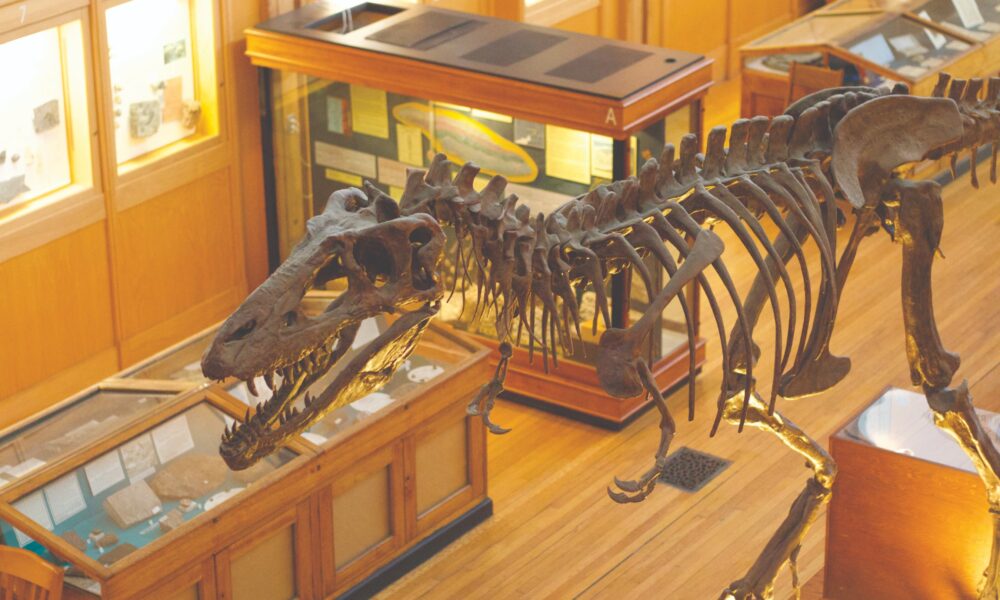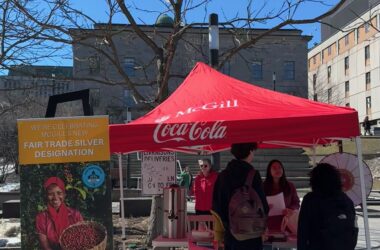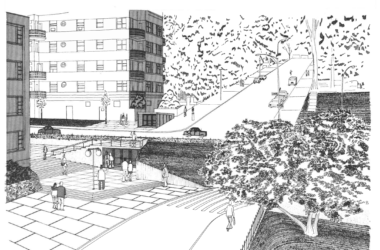The reopening
Scores of excited visitors crowded the entrance to McGill’s Redpath Museum on Jan. 10 for its long-awaited reopening. Since March 2020, Redpath Museum, overlooking lower field, has been closed in accordance with Quebec’s and McGill’s COVID-19 health and safety guidelines.
Ginette Dessureault, the museum’s administrative assistant, explained that the museum’s decision to reopen was made in close consultation with McGill.
“McGill wanted to take a very cautious approach to reintegrating […] the students and staff safely into the building, and see how a couple [of] semesters went […] post-pandemic,” Dessureault said in an interview with The McGill Tribune. “The timing is now right to reopen the museum because we know we’ll be open for a fair amount of time. There was some hesitancy about mixing the general public with the student population, [so] we wanted to make sure it was a safe time to do it.”
During its closure, the museum’s usual tours shifted to an online platform, allowing them to showcase their exhibits virtually, such as in the Biodiversity exhibit virtual tour. However, as Dessureault notes, a large part of the museum’s draw is seeing its collections in person.
“We had a few really successful virtual events, but really the core of our essence is to have the public here to see [the exhibits], to interact with [them],” Dessureault said. “The experience, being in person, is a tactile experience. All your senses are engaged, so I think it is a lot more pleasant for the visitor.”
The pieces remained at the museum all throughout the pandemic, and curators conducted safety checks to keep the museum’s collection well preserved.
“There was always somebody here to monitor [and] […] to ensure the integrity of the collections,” Dessureault said.
The experience
The museum’s pieces mainly focus on the natural sciences, with exhibits spanning from ethnology and biology to paleontology and geology. The Museum’s artifacts span multiple millennia, with fossils of some of the oldest known vertebrates, rare artifacts from prehistoric cultures, and taxidermied animals.
The Redpath Museum was built in 1882 as a gift to the university from businessman and sugar baron Peter Redpath to commemorate the 25th anniversary of Sir John William Dawson’s appointment as Principal of the university. Dawson was an acclaimed natural scientist with a valuable collection of geological pieces and other specimens to be displayed for students and the public.
For many students, seeing these pieces for the first time in person was a worthwhile experience.
“[The museum] definitely surpassed my expectations,” Zareen Subah, U1 Management, said while visiting the museum. “The Tyrannosaurus Rex was my favourite, just the jaw itself was half the size of my upper body, so that was pretty cool.”
Ryan O’Connell, U1 Arts, was observing a display on the museum’s first floor, before speaking to the Tribune.
“I am so happy that something like this exists on campus,” O’Connell told the Tribune. “This is a great way to spend an hour or something in between classes [….] It was unfortunate I could not do that last year, but now I can.”
Though the museum sits right at the heart of campus and its steps have always been a popular place for students to gather, Dessureault explained that the closure affected students’ knowledge of the broader offerings held in-house at the university.
“We have found that many McGill students don’t even know about this building. [These students] have come in [the last couple of days] and didn’t even know that we had this resource on campus.”
Mahin Usman, U2 Arts, has been awaiting Redpath’s opening, wondering if she would get the chance to visit it before she graduated. “I remember passing by [the museum] a couple of times. And thinking, ‘this seems super interesting.’ I wanted to check it out, but I saw online that it was closed. So, in the back of my head, I have been hoping it would open before I graduated.”
Museum Educator Sara Estrada Arevalo began working at Redpath just a few months before the closure in 2020. Arevalo’s role at the museum was altered quickly by the rapid shift to virtual tours.
Arevalo expressed her excitement at returning to in-person tours after the extended shutdown.
“I think it’s one of the jewels of McGill because of its historical value and because of all the collections we have,” Arevalo said in an interview with the Tribune. “This museum was built to share collections with the public, so having visitors coming and having the opportunity to be in contact with the collections and learning from them is pretty exciting.”
The museum offers a low-commitment opportunity for students to participate in an educational visit that they may not have sought out further afield.
“We are happy to be open and welcome all the visitors we’ve had in the past [few] days. It’s been just phenomenal. And the response has been incredible,” says Dessureault. “We really strive to serve the community, to see all the faces again and have everybody come back.”
O’Connell encouraged the rest of the McGill community to pay the museum a visit, and noted the museum had “mass appeal” thanks to the variety of exhibits.
“It is absolutely surreal to just stand a few inches, and all that’s separating you is glass, from something that is 200 million years old. When can you say that you have that experience in your everyday life?”
The Redpath Museum Society (RMS) also allows students to get involved by assisting professors and curators of the museum with tours, events, and workshops.
Confronting the past
Though the museum preserves artifacts in stasis, it can also serve as a site for change through ethical and decolonial approaches to museum going. Redpath Museum features several archeological and ethnographic objects gathered through theft or illegal trading. James Ferrier, a former McGill Chancellor, contributed to Redpath Museum’s collection with Egyptian mummies that were presumed to have been acquired illegally from an illicit antiquities market. Another familiar name, Thomas Roddick, former Dean of McGill’s Faculty of Medicine, donated another mummy in 1895 after a colonial British military mission in Egypt. Both of these household names that are celebrated around our campus participated in the theft of ancient artifacts that still sit in the Redpath Museum today.
Redpath is not the only Western museum to display artifacts out of context, diminishing their cultural and historical significance. Recognizing this fact could offer a different way of viewing at an exhibit like the World Cultures collection, where a critical perspective on conservation, curatorship, and preservation can trouble and open conversations about the holdings from Central Africa and Egypt. Just as the McCord Museum’s exhibit on Indigenous Voices has sparked similar discussions, working to empower sovereignty and vitality from larger arts communities remains a prescient and collaborative endeavour.









Just a wry, but true, comment about mummy “theft”: In the late 1800s Egyptian mummies were very commonly found in large quantity in Egypt. When the north american paper industry that wished to make quality papers known as “rag papers” were running out of rags for rag fiber content, it was proposed seriously to import quantities of rag material from unwrapped mummies in Egypt which were EVERYWHERE easily found. The bones were to be burned on site for carbon black (for pigments etc) and the cloth wrappings shipped to fine paper manufacturers in the U.S.A. The economics were borderline but only just. Now a new mummy find seems to be presented as a huge achievement. Makes one think for sure. (The Egyptians mummified not only humans but also cats etc. ) It is now thought that mummy preservatives and wrapping was not necessarily for preservation purposes but possibly for ritual or other reasons. I found this story hard to believe until I confirmed it from reading an Encyclopedia dating from about 1890.
Congratulations on the re-opening of the Redpath Museum. As a McGill graduate geologist I remember well my earlier visits in the 60’s. Robin Doak . (Class of 1968).